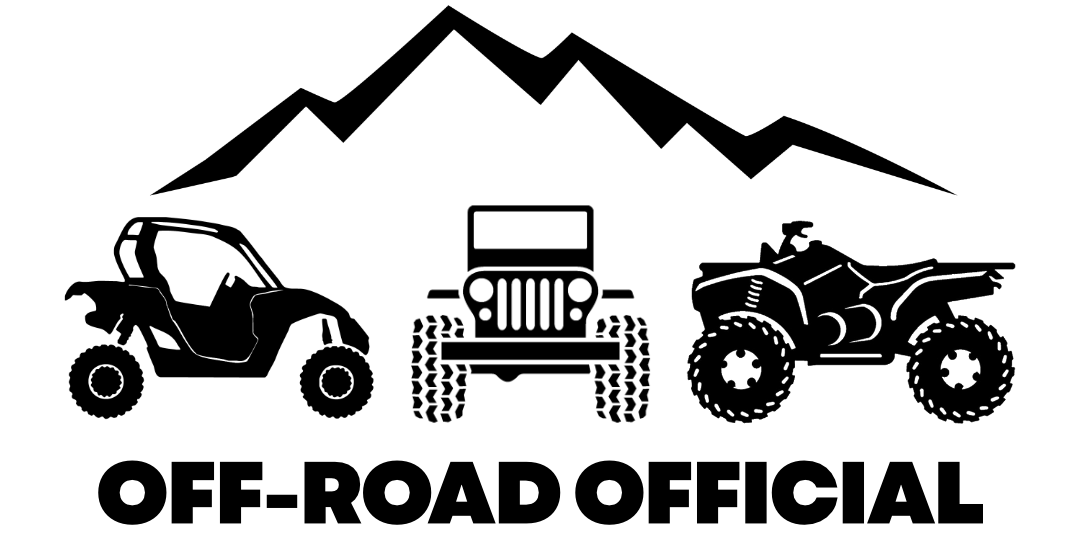Kawasaki has been one of the biggest players in the off-road vehicles industry for decades, offering a number of different models to satisfy the demand of outdoor enthusiasts who do riding of all different types.
There’s the line of utility-focused Kawasaki Mule side-by-sides.
There’s the utility/recreational blend in the line of Kawasaki Brute Force ATVs.
And then there are the Teryx models, which are Kawasaki’s full sport side-by-sides.
All of them are known for being some of the most durable and dependable models in their respective industries.
And while the Teryx models offer a number of advantages over some of the sport side-by-side competition, they don’t come without a few drawbacks.
This Kawasaki Teryx review will detail both the strengths and weaknesses of these models, including:
- Brief comparison of current Kawasaki Teryx models
- How well they’re built
- How well they perform
- Design and durability
- What owners like
- What owners dislike
2024 Kawasaki Teryx Models And Starting MSRP
There are four different Kawasaki Teryx models available for 2024:
- Teryx ($16,199)
- Teryx 4 ($18,199)
- Teryx KRX 1000 ($23,199)
- Teryx KRX 4 1000 ($27,499)
The standard Teryx is a two seater, and the Teryx 4 is a four-seater. The Teryx offers two trim levels and the Teryx 4 offers four trim levels.
These models are commonly referred to as the Teryx 800 as they are equipped with a 783cc V-Twin engine.
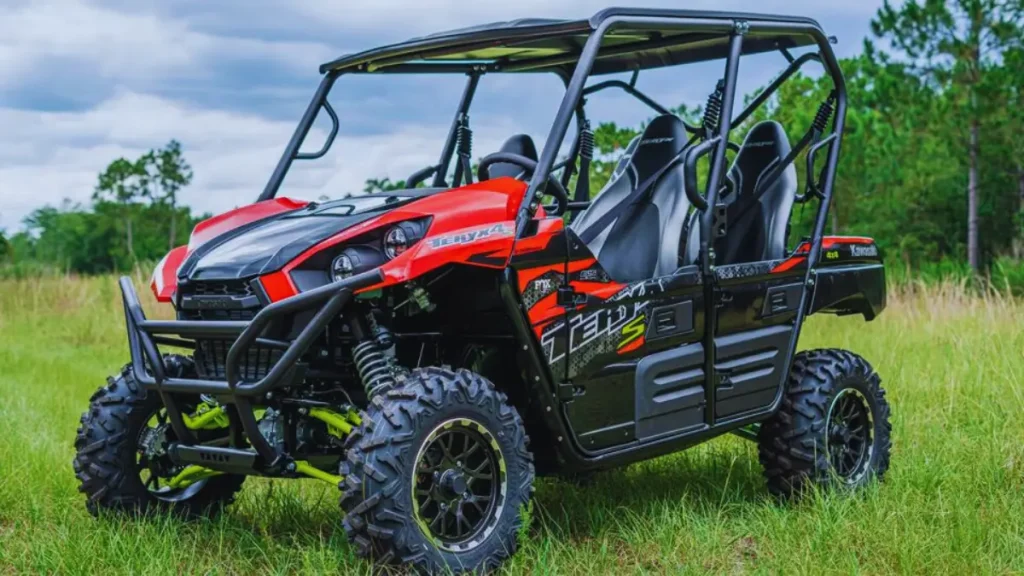
The Teryx KRX 1000 is a two-seater which offers four different trim levels, while the KRX 4 1000 is a four-seater that comes in three different trim levels.
These models feature a 999cc parallel-twin engine.
The main differences in the Teryx and Teryx KRX models are:
- KRX models feature a more powerful engine
- KRX models offer sportier overall performance
- KRX models feature sportier build styles
- KRX models are bigger overall in size
Build Quality & Performance
Engines
Each Teryx model is equipped with one of Kawasaki’s signature liquid-cooled engines.
You’ll be hard-pressed to find an engine more durable or reliable than that of Kawasaki, and you’ll rarely experience issues as long as you service them regularly.
All models feature electronic fuel injection, adding to their reliability and offering better fuel efficiency.
As far as performance goes, these engines are well-rounded but don’t offer quite the performance you’ll find in some of the sportiest side-by-sides like the Polaris RZR 1000 or the new 2024 Can Am Maverick R.
Engine Pros
- Durable, dependable and overall high quality
- Excellent low-end power and torque
- Great initial acceleration
These engines offer excellent low-end power and torque, and you’ll notice the impressive acceleration right off the line in the Teryx models.
This translates to the machines being able to handle just about any trail or terrain you throw at them. Mud, water crossings, hills – they conquer easily.
They do fine in the sand, but may feel a bit underpowered when riding sand dunes.
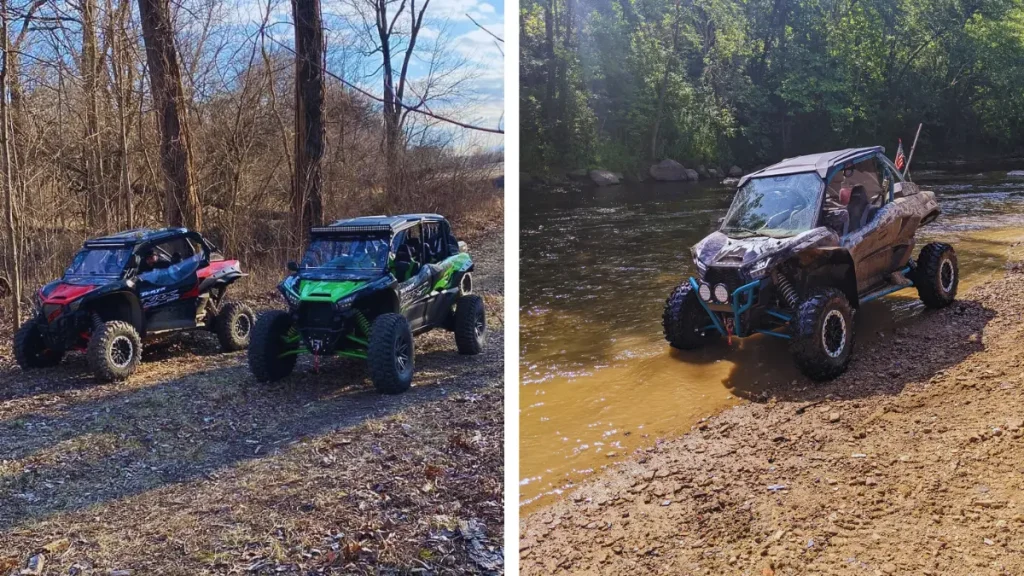
Once you get into the mid to upper RPM ranges is where these engines can’t hang with sportier side-by-side models.
You’ll find that acceleration drops off in these RPM ranges, so you don’t get quite the zip you might hope for when throttling.
And Kawasaki is big on ensuring the engines don’t get overworked, so they install a speed limiter in all of their vehicles which limits the top-end speed in the Teryx models and keeps them from being as fast as some competition.
Lastly, the engine/exhaust noise can be overly loud in the cab while riding, making it hard to hear your passengers while accelerating.
Engine Cons
- Underpowered for dune riding
- Lack or acceleration and speed in upper RPM ranges
- Loud in cab area
Drivetrains
The Teryx models all offer selectable 2WD/4WD, with a shaft drive powering the front and rear wheels. The front differential also locks for added traction when needed.
When you throw these machines into 4WD, there’s really no terrain they can’t conquer.
These models are equipped with an automatic CVT transmission and centrifugal clutch.
The tranny used in these machines offers excellent throttle response, with no real lag in acceleration when throttling like can happen with some CVT-style transmissions.
Drivetrain Pros
- Selectable 4WD and front locking differential
- No lag in throttle response with CVT transmission
Each model offers both a High and Low gear, along with Neutral and Reverse. You’ll need to use the parking brake when stopped with the lack of a Park setting.
While some folks are not fans of a CVT-style transmission due to the tendency for drive belt issues to surface, the one used by Kawasaki is plenty reliable.
As long as you’re conscious of the speeds you’re driving at and the gear you’re in, you shouldn’t have issues.
If you’re driving anywhere around or under 25 mph, you’ll likely want to stay in Low gear as prolonged low speeds in High gear are what leads to belt burn.
Drivetrain Cons
- No Park setting
- Need to be aware of speeds/gears to avoid drive belt damage
Suspensions
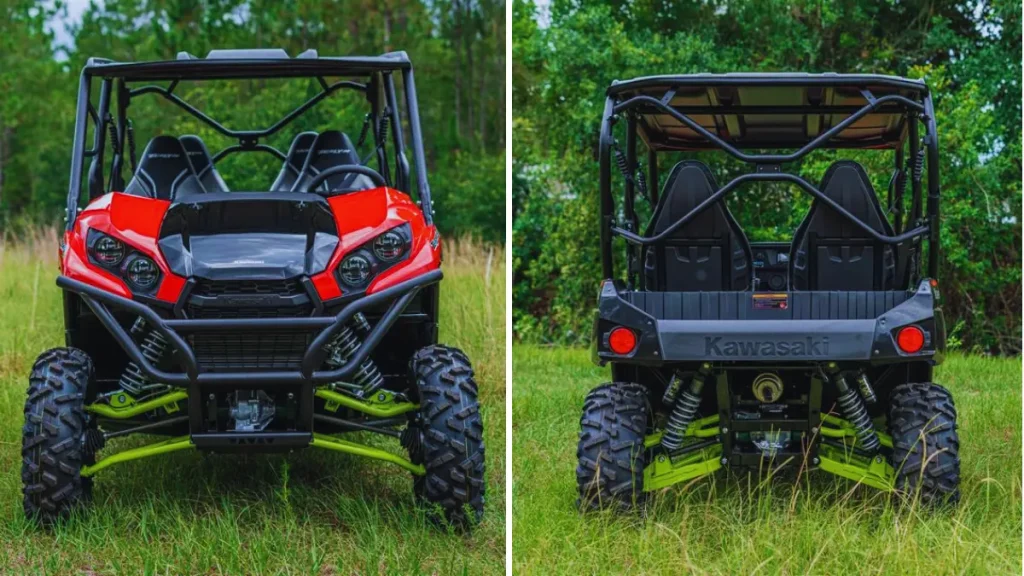
The standard Teryx models and KRX models make use of slightly different suspension systems.
The standard Teryx models each make use of double wishbone suspensions in the front and rear, offering various suspension travels of between 8 and 10 inches depending upon the trim level.
The Teryx KRX models are equipped with a double wishbone suspension up front and a 4-link trailing arm rear suspension in the rear more suited to aggressive trail riding.
All models offer Fox podium shocks with adjustable preload, with those in the KRX models being more aggressive and offering more adjustability.
Suspension Pros:
- Smooth and comfortable ride in all terrain
- Adjustable preload settings offer plenty of customization
- Rarely tippy even when cornering at fast speeds
Overall, the suspension systems on these models do a great job of soaking up chop in the trail to make for a smooth and comfortable ride, no matter the terrain.
They also help to provide these models with a low center of gravity so that they rarely feel tippy, and even at high speeds when cornering the back will slide out and keep these vehicles level.
Ground clearance varies from between 11 inches and 14 inches by model/trim level. The KRX models tend to have plenty, but you may find yourself scraping some rocks on uneven trails in the standard Teryx models.
Even so, the entire underside of the vehicle is protected by skid plates.
Suspension Cons:
- Smaller wheelbase and less travel in standard models can make for bumpy ride
- Ground clearance in standard models can lead to some bottoming out on trails
Build Quality & Design
The Kawasaki Teryx models are known for being built well with high quality parts and components that stand up well to the abuses of off-road riding.
These models were designed to provide comfort throughout long and extended rides in the wilderness and are some of the best you’ll find in this regard.
The cab areas offer plenty of space and legroom, even for larger riders. And unlike some other models, you won’t feel cramped sitting in the rear seats.

And speaking of the seats, they are big, supportive, and comfortable. And there are grab bars in the rear and front passenger side that provide good stability.
Underneath the vehicle, steel plates protect the wheel wells to prevent branches or logs from puncturing them.
And a combination of steel and plastic skid plates run the full length of the underside of these models, with steel covering the areas that need the most protection.
What Owners Like
- Some of the most durable, dependable engines in the industry.
- Excellent low end power and acceleration off the line.
- Cab is roomy enough for bigger riders, even in the rear row seating.
- Can comfortably fit four adult riders for extended rides in the 4-seaters.
- Rear grab bars and passenger side grab handle offer good stability while riding.
- Small rear bed is just the right size to fit some gear while not sacrificing for cab space.
- Seats are big, contoured, and comfortable.
- Rear seats are stadium style and sit slightly higher than front seats.
- Tilt-up adjustable steering wheel.
- 2-inch hitch receiver and towing capacity of 1,300 lbs.
- Drain holes in the flooring helps water escape quickly.
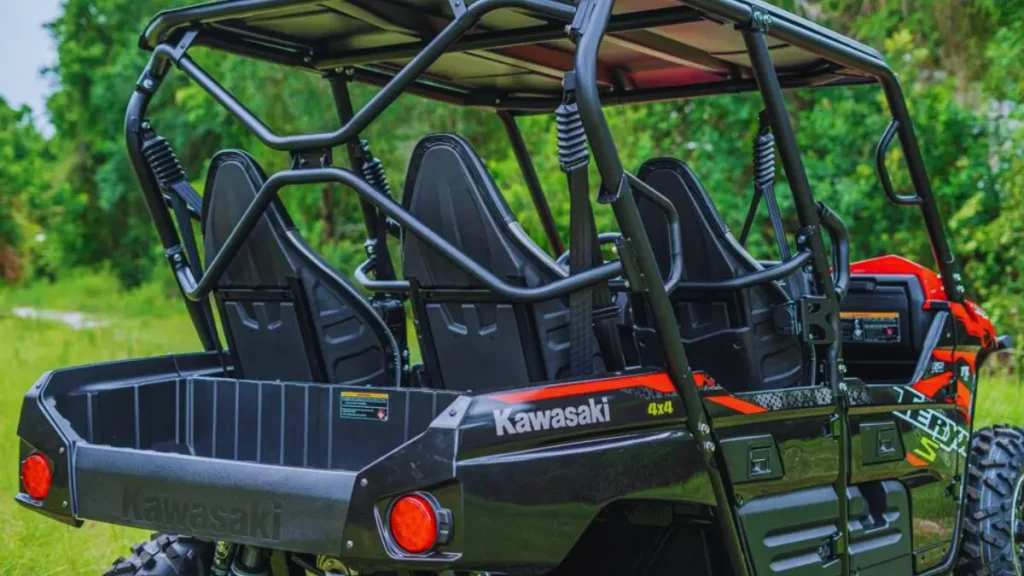
What Owners Dislike
- High gear doesn’t offer the acceleration or top-end speed of some sportier models.
- Speed governor kicks in earlier than you might like in a sport side-by-side.
- The engine/exhaust noise in the cab is loud, making it hard to hear your passengers without taking your foot off the gas.
- The cab tends to get hot due to warm air venting in from the radiator and engine areas.
- There are only door handles on the outside of the doors, requiring you to reach over from the inside to open them.
- The driver’s seat is adjustable, but only offers about 2 inches of travel when sliding forward or backward.
- The location of the front cup holders directly behind the shifter is inconvenient and tends to lead to your drinks heating up rather quickly.
You can read more into some of the drawbacks and how to overcome them in this guide to the most common problems with the Kawasaki Teryx KRX 1000.
Kawasaki Teryx Top Speeds
The Kawasaki Teryx 800 models will reach a top speed of around 50 mph, with a speed governor kicking in and limiting them in High gear.
The Kawasaki Teryx KRX 1000 models can reach a top speed of between 65-70 mph, with a speed governor restricting them in High gear as well.
The good news for those who want to go faster is that you can have the ECU flashed or tuned in order to delete this speed governor and reach slightly faster speeds.
Final Word
If you’re looking to explore miles of trail systems or take long rides with the family, the Kawasaki Teryx makes an excellent choice.
They’re well-rounded machines that offer enough speed and power to get you through tough terrain and give you a thrill while doing it.
But they’re not on the same level as some of the highest performing sport side-by-sides, and if speed is your thing, you’re probably better off looking at a different model.
For more Kawasaki, check out the following:
